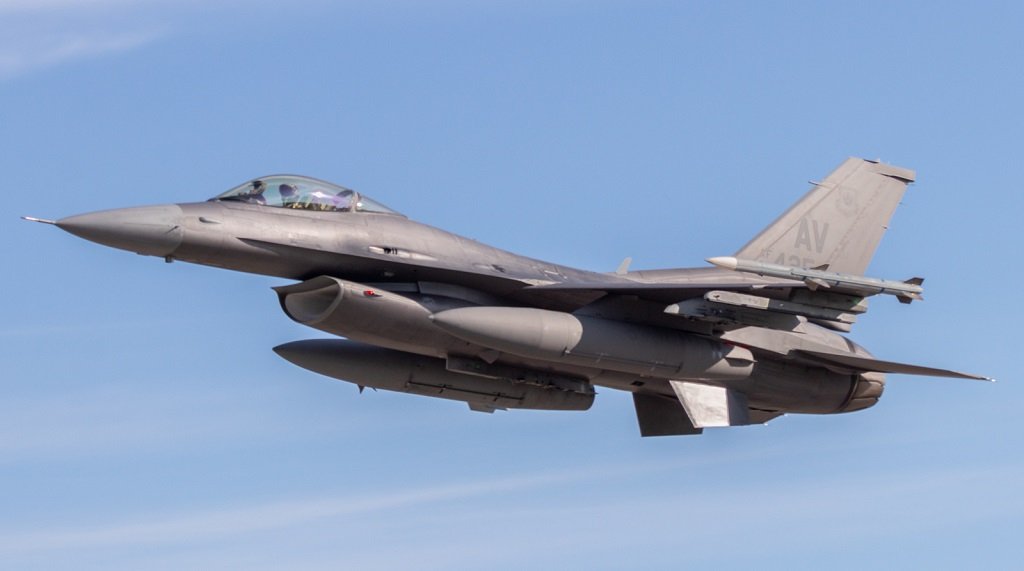[ad_1]

The AN/ALQ-257 Integrated Viper Electronic Warfare Suite is set to replace the legacy EW systems of the U.S. Air Force F-16 fleet.
The U.S. Air Force and Northrop Grumman are working together to modernize the electronic warfare capabilities of the F-16 fleet, as part of the planned Post Block Integration Team (PoBIT) upgrades. IVEWS provides a next generation EW system that is internal to the F-16 and interoperable with the new on-board APG-83 Active Electronically Scanned Array (AESA) radar.
The program which resulted in the creation of the AN/ALQ-257 started in 2019. After developing an IVEWS environmentally and safety of flight certified prototype following a first contract in 2021, last year Northrop Grumman was contracted to complete the development and install the system on several F-16s for flight testing. In April, the company announced that IVEWS has completed U.S. Air Force Laboratory Intelligence Validated Emulator (LIVE) testing.
“As advanced radio frequency threats continue to proliferate, the protection afforded by IVEWS is essential,” said James Conroy, vice president, navigation, targeting and survivability, Northrop Grumman. “This successful evaluation under very challenging conditions is an important step on the path to fielding the suite.”
According to the press release, the system exceeded multiple benchmarks and demonstrated the ability to counter modern radio frequency (RF) threats. This was the first time the ultra-wideband architecture of the AN/ALQ-257 IVEWS underwent LIVE testing. LIVE is an intelligence validated, closed-loop RF direct-injection threat radar emulator based on threat capabilities and features, which allows for the testing electronic warfare systems in realistic environments.
During the test, simulated air defense radar pulses were injected directly into IVEWS to verify the suite’s ability to recognize and counter advanced threats. The signals used in LIVE testing are validated models that provide realistic representations of radio frequency threatsc. This rigorous testing program is necessary to ensure that IVEWS will be ready to protect the fourth-generation fighter fleet against the proliferation of advanced radio frequency threats.

“This contract and overall program effort is vital to increase the protection of our F-16 operators as they execute their missions in contested environments,” said last year Maj. Charles Prichard, Chief of Electronic Warfare Integration within the directorate’s F-16 System Program Office. “In order for the F-16 Viper to meet assigned mission sets in line with the CSAF’s Fighter Roadmap and operate in certain environments, the fleet needs an advanced electronic warfare (EW) system. IVEWS lines up with HAF/ACC’s EW plan and recently became the solution that improves the F-16’s survivability and lethality against current and emerging threats.”
IVEWS is fully digital and founded on secure, modular, open systems design principles, with the receiver/exciter architecture providing significant advantages over heritage systems. This technology, according to Northrop Grumman, allows for extended frequency coverage, full spatial coverage, and more rapid responses, allowing operations in contested environments.
Featuring highly efficient broadband power amplifiers and adaptive countermeasure modulations, the AN/ALQ-257 is designed to detect, identify, locate, and defeat next generation sensors and weapons. It is designed to Open Missions Systems requirements and provisioned for long-term growth capability to support future upgrades such as the Fiber Optic Tow Decoy, Adaptive/Cognitive Processing, and Open System Architecture compliance.
Mr. Conroy provided us more details in an emailed statement and confirmed that IVEWS is a complete EW suite, including an integrated digital radar warning receiver (RWR). Although IVEWS utilizes existing antenna locations, the system also uses next-generation antennas to provide the awareness required for operation in advanced threat environments.
IVEWS and its advanced architecture are also fully interoperable with Active Electronically Scanned Array (AESA) radars, including the AN/APG-83 SABR which is being installed on the F-16s of the US Air Force fleet. In fact, IVEWS demonstrated real-time integration with the APG-83 radar during rigorous testing in dense electromagnetic spectrum environments against ground-based and airborne emitters.

The company used one of their flying testbeds, a CRJ-700 equipped with IVEWS and a SABR radar inside an F-16’s nosecone, during Exercise Northern Lightning in 2021. The two systems demonstrated full pulse-to-pulse, multi-function interoperability in a contested operational environment. With SABR successfully engaging multiple air and ground targets, IVEWS detected and identified a range of advanced threats, employing advanced jamming techniques capable of defeating those threats when required.
Avoiding legacy methods of radio frequency compatibility ensures that both systems are able to simultaneously operate without restriction to deliver advanced levels of survivability without compromising performance. In fact, one of the most critical aspects of EW systems’ and AESA radars’ testing is to assess that they are interoperable without generating significant interferences.
The ALQ-257 IVEWS is a completely internal electronic warfare suite, incorporating all Electronic Warfare functionality, including jamming of current and future threats. This means that it incorporates all functions previously performed by the ECM pods, freeing the F-16’s centerline station from the ALQ-131 and ALQ-184 pods and allowing it to be used for the 300 gal external fuel tank or other payloads.
IVEWS is currently a program of record electronic warfare suite for the U.S. Air Force F-16 fleet. The system is also exportable for current and previous generations of the F-16. Northrop Grumman is continuing to develop IVEWS in preparation for additional testing and integration on an actual aircraft, with the first F-16 flight expected in 2023.
The production and fielding of IVEWS, with the goal of equipping as many as 450 F-16s, is expected to begin in 2024. However, although Col. Tim Bailey, F-16 System Program Manager, said last year that IVEWS is a ‘must have,’ top priority program to keep the Viper relevant and lethal throughout its extended service life, there are some reports that the Air Force might shift funding away from modernization of the F-16 to prioritize next-generation aircraft.
Until the service takes a final decision, Northrop Grumman is continuing with the development program, with the goal of having the next gen EW system ready for fielding as per contract schedule.
[ad_2]
Source link
